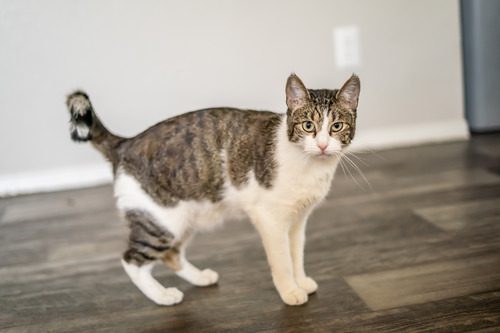Signs of a Broken Tail in Cats: How This Can Be Treated
A cat’s tail is an extension of its spine, providing balance, communication, and coordination. When an injury occurs, it can lead to discomfort, mobility issues, and changes in behavior. A broken tail in cats is a serious concern that requires veterinary evaluation. While some injuries may heal on their own, others can cause long-term problems if left untreated. Recognizing the signs of a broken tail in cats can help pet owners act quickly and seek appropriate care. If you are concerned about your cat’s tail, call Frontier Veterinary Urgent Care at 262-226-2055.

What Are Some Common Causes of a Broken Tail in Cats?
Cats are agile and resilient, but accidents can still happen. A broken tail in cats often results from trauma, and understanding the common causes can help prevent future injuries.
Accidental Trauma
One of the most frequent reasons for a broken tail is accidental injury. Cats may get their tails caught in doors, stepped on, or pulled by children. Even a minor incident can result in fractures or nerve damage.
Falls and Collisions
Cats are natural climbers, but misjudging a jump or falling from a high surface can lead to tail fractures. Collisions with furniture or other obstacles during high-speed chases can also cause serious injuries.
Animal Attacks
Fights with other animals, such as dogs or other cats, can lead to tail injuries. Bites and scratches may cause fractures, deep wounds, or even infections.
Being Hit by a Car
Outdoor cats face a greater risk of tail injuries due to traffic. A car impact can lead to severe trauma, including broken tails, nerve damage, or even more critical injuries.
Signs of a Broken Tail in Cats
If you notice any of the following signs, contact Frontier Veterinary Urgent Care at 262-226-2055 for a thorough evaluation.
- Sudden Changes in Tail Position: A cat’s tail should move freely and naturally. If the tail is limp, held at an unusual angle, or not moving at all, this may indicate a fracture or dislocation.
- Pain or Sensitivity: A cat with a broken tail may react negatively when the area is touched. They might flinch, hiss, or even try to bite if they are in pain.
- Swelling and Bruising: Inflammation around the injury site is a common symptom. Swelling, redness, or bruising along the tail suggests a possible break.
- Difficulty Walking or Balancing: The tail plays a crucial role in a cat’s balance. A broken tail in cats can affect their coordination, leading to unsteady movement or hesitation when jumping.
- Changes in Behavior: Cats experiencing pain may become withdrawn, hide more often, or show signs of aggression. A change in appetite or reduced grooming habits can also signal discomfort.
- Loss of Tail Function: In severe cases, a cat may lose the ability to move their tail entirely. This could indicate nerve damage, which requires immediate veterinary attention.
How a Broken Tail in Cats Is Diagnosed
Veterinarians use a combination of physical exams and diagnostic tools to assess tail injuries. If you suspect a broken tail in cats, a prompt veterinary visit is necessary.
Physical Examination
Your veterinarian will carefully examine the tail for signs of pain, swelling, or deformity. They will also check for any signs of nerve damage or underlying conditions.
X-rays and Imaging
Radiographs (X-rays) help confirm whether the tail is fractured, dislocated, or otherwise injured. In some cases, advanced imaging may be necessary for a more detailed assessment.
Neurological Evaluation
If the injury is severe, the veterinarian may test for nerve function. Damage to the nerves can impact tail mobility, bladder control, and overall sensation.
Treatment Approach for a Broken Tail in Cats
Treatment for a broken tail in cats depends on the severity of the injury. While minor fractures may heal on their own, more serious cases require medical intervention.
Pain Management
Managing discomfort is a priority. Veterinarians may prescribe pain relievers or anti-inflammatory medications to keep the cat comfortable during recovery.
Limited Movement and Rest
Encouraging rest and limiting activity can help a fractured tail heal properly. Some cats may need to be confined to a small space to prevent further injury.
Bandaging or Splinting
In certain cases, your veterinarian may apply a bandage or splint to support healing. However, this is not always possible due to the tail’s flexibility.
Surgery
Severe fractures or cases involving nerve damage may require surgery. Amputation is sometimes necessary if the tail is severely injured and cannot heal properly.
Monitoring for Complications
Regular follow-up visits are essential to monitor healing progress. Infections, abscesses, or persistent pain should be addressed promptly by your veterinarian.
Tips for Preventing Tail Injuries in Cats
While not all accidents can be avoided, taking steps to protect your cat from tail injuries can reduce risks.
- Ensure your home is free of hazards that could cause tail injuries. Close doors gently, secure windows, and avoid leaving heavy objects in high-traffic areas.
- Teach children how to handle cats gently and prevent rough play that could result in tail pull injuries. If you have multiple pets, monitor their interactions to prevent fights.
- Outdoor cats face greater risks of tail injuries due to cars, other animals, and unpredictable environments. If your cat enjoys the outdoors, consider a secure catio or supervised outdoor time.
If you suspect a broken tail in cats, prompt veterinary attention is necessary. Even if the injury seems minor, complications such as nerve damage or infections can develop over time. Frontier Veterinary Urgent Care is here for your pet when they need it most. Call us at 262-226-2055, so our team can assess your cat’s condition and provide the best possible care for their recovery.
